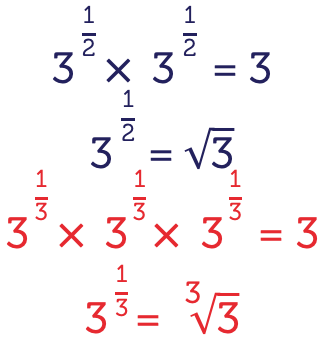Fractional indices
An index can be an integer – a counting number - either positive or negative. It can also be a fraction such as \(\dfrac{1}{2}\), \(\dfrac{3}{4}\), or \(2.5\). Use this resource to learn how the laws of indices apply to fractional indices.
Index laws
Remember the basic index laws:
\(a^{m}\times a^{n}=a^{m+n}\)
\(a^{m}\div a^{n}=a^{m-n}\)
\(\left(a^{m}\right)^{n}=a^{mn}\)
\(a^{0}=1\)
\(a^{-n}=\dfrac{1}{a^{n}}\)
These hold when \(m\) and \(n\) are whole numbers or fractions. From this point onwards, we will refer to them as the first index law, the second index law, and so on.
Basic fractional indices
Let's consider the fractional index, \(3^{\frac{1}{2}}\).
Using the first index law:
\[\begin{align*} 3^{\frac{1}{2}}\times3^{\frac{1}{2}} & = 3^{\frac{1}{2}+\frac{1}{2}}\\
When \(3^{\frac{1}{2}}\) is multiplied by itself, it gives the base, \(3\). This is the same as:
\[\sqrt{3}\times\sqrt{3}=3\]
Therefore, we can say that:
\[3^{\frac{1}{2}}=\sqrt{3}\]
Now, let's consider \(2^{\frac{1}{3}}\).
Using the first index law:
\[\begin{align*} 2^{\frac{1}{3}}\times2^{\frac{1}{3}}\times2^{\frac{1}{3}} & = 2^{\frac{1}{3}+\frac{1}{3}+\frac{1}{3}}\\
\(2^{\frac{1}{3}}\) therefore behaves like the cube root of \(2\):
\[2^{\frac{1}{3}}=\sqrt[3]{2}\]
In general, we say that \(a^{\frac{1}{n}}\) is the \(n^{\textrm{th}}\) root of \(a\). That is:
Example 1 – evaluating basic fractional indices
Evaluate \(4^{\frac{1}{2}}\).
Evaluate \(27^{\frac{1}{3}}\).
Evaluate \(3^{\frac{1}{4}}\).
\[\begin{align*} 3^{\frac{1}{4}} & = \sqrt[4]{3}\\
& = 1.32
\end{align*}\]
In most cases, the root of a number will not be able to be written as a whole number or fraction and will be an irrational number.
Evaluate \(b^{\frac{1}{5}}\).
Evaluate \(x^{\frac{1}{2}}\).
Evaluate \(32^{-\frac{1}{5}}\).
Exercise – evaluating basic fractional indices
Evaluate the following expressions. If the answer is not exact, use a calculator to give a decimal approximation to two decimal places.
\(64^{\frac{1}{2}}\)
\(125^{\frac{1}{3}}\)
\(36^{\frac{1}{4}}\)
\(81^{-\frac{1}{2}}\)
\(128^{-\frac{1}{7}}\)
\(250^{\frac{1}{5}}\)
\(8\)
\(5\)
\(2.45\)
\(\dfrac{1}{9}\)
\(\dfrac{1}{2}\)
\(3.02\)
More complicated fractional indices
Consider the fraction index, \(a^{\frac{2}{3}}\).
Using the third index law:
\[\begin{align*} a^{\frac{2}{3}} & = \left(a^{2}\right)^{\frac{1}{3}}\\
Since \(2\times \dfrac{1}{3}\) is the same as \(\dfrac{1}{3}\times2\), we can write:
\[\begin{align*} a^{\frac{2}{3}} & = a^{2\times\left(\frac{1}{3}\right)}\\
In general,
Example 1 – evaluating more complex fractional indices
Evaluate \(5^{\frac{3}{4}}\).
Evaluate \(7^{\frac{5}{2}}\).
Evaluate \(a^{\frac{7}{5}}\).
Evaluate \(y^{-\frac{3}{4}}\).
Evaluate \(\sqrt[4]{x^{3}}\).
Simplify and evaluate \(3^{\frac{1}{3}}\div3^{\frac{4}{3}}\).
Simplify and evaluate \(32^{\frac{3}{5}}\).
Simplify and evaluate \(25^{-\frac{1}{2}}\).
Exercise – evaluating more complex fractional indices
Simplify the following expressions. Give your answers in index notation with positive indices.
\(\left(\frac{8}{27}\right)^{\frac{2}{3}}\)
\(\sqrt{5}\times\sqrt[3]{5}\times\sqrt[6]{5}\)
\(2^{\frac{5}{2}}-2^{\frac{3}{2}}\)
\(\frac{2^{2}}{3^{2}}\)
\(5\)
\(2^{\frac{3}{2}}\)
Images on this page by RMIT , licensed under CC BY-NC 4.0
Further resources
Indices
Use this resource if you need a refresher on the index laws.
Copy the iframe code above.
Go to the course in Canvas where you want to add the content.
Navigate to the page or module where you want to embed the content.
In the Rich Content Editor, click on the "HTML Editor" link.
Paste the iframe code into the HTML area.
Switch back to the Rich Content Editor to see the embedded content.
Save the changes to your page or module.
Note: Ensure that your permissions allow embedding external content in your Canvas LMS instance.
